The crisis of 1998, which swept many countries of the world, did not pass by the Russian Federation either. For the Russian economy, the nineties became one of the most difficult times. The authorities during this period were simply not able to repay the entire volume of domestic loans. The depreciation of the ruble against other currencies, the liquidation of banking institutions, the wave of mass closure of enterprises - all this terrified the population of Russia. The 1998 financial crisis ended relatively quickly. But then no one could have thought that in the future the financial problem would turn in a completely different direction.
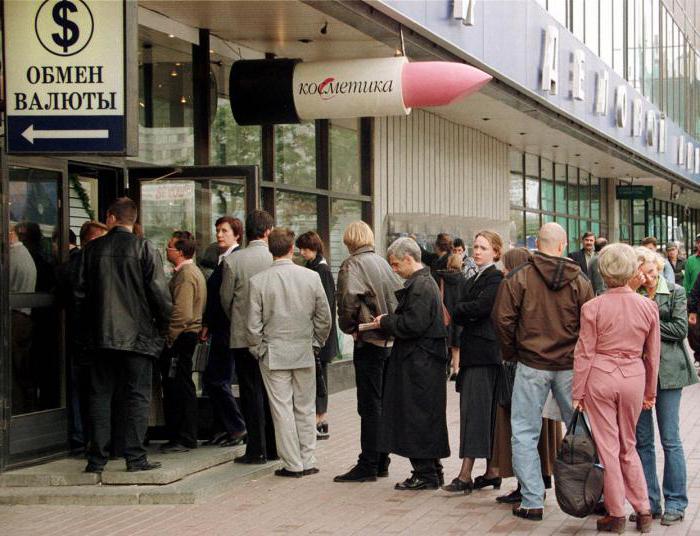
Sources of problems
Events such as the 1998 crisis in Russia do not happen instantly. The rapid deterioration of the financial situation was preceded by a huge number of processes. Problems accumulated over a long period of time, so the peak fell right at the end of the nineties.
Destructive economic phenomena originated in the days of the Soviet Union. In the seventies, the chosen path to combat inflation was an artificially created shortage of money supply. This had a positive effect in the form of lower inflation. But at the same time, the negative consequences simply overlapped the achievements.
Such a policy led to a sharp shortage of money supply in circulation. By the time the active stage of the crisis began, the ratio of the average annual aggregate of money supply to the gross domestic product barely reached ten percent. This ratio is optimal when the value is seventy-five percent. In this situation, the volume of domestic debt has steadily increased.

The government has proposed the following anti-crisis measures:
- increase in tax rates;
- rise in rent;
- increase in utility tariffs.
But the action did not bring the expected results, since the number of the population that was not able to pay the bills was growing. The number of illegal financial procedures and operations that most of the private entrepreneurs worked on increased. The emergence of shadow schemes contributed to the organization of companies to cash out money received in an unfair way. The measures introduced by the state were not effective, since huge amounts "went into the shadows." But the high ranks also did not neglect such frauds.
The collapse of the Soviet Union
In many ways, the 1998 crisis in Russia was caused by another historical phenomenon - the formation of a number of independent states from among the republics of the USSR. It was on the shoulders of the Russian Federation, as the successor of the USSR, that all the debts of the former great power fell. That is, what all republics were obliged to give to other states passed to the Russian Federation. Payments on loans grew steadily, and just cosmic amounts accumulated.
The stimulation of the local currency was artificial. This is evident from the fact that the prices of domestic and foreign products were disproportionate. The cost of overseas goods was so low that even powerful Russian enterprises were uncompetitive. This impeded the development of sectors of the national economy, because most of the needs were covered by imported products.
Inflationary processes
The 1998 crisis in Russia was marked by a significant increase in the general level of prices for goods and services. Over five years, inflation indicators have increased tens of times, which indicates a significant acceleration of the crisis processes in this period.The government did not pay any attention to inflation and had no power over it.
In addition, any developed state is distinguished by worthy work of high-tech enterprises, which cannot be said about the Russian Federation in 1998. The financial crisis (Russia) gave hope for the survival of only the raw materials industry.
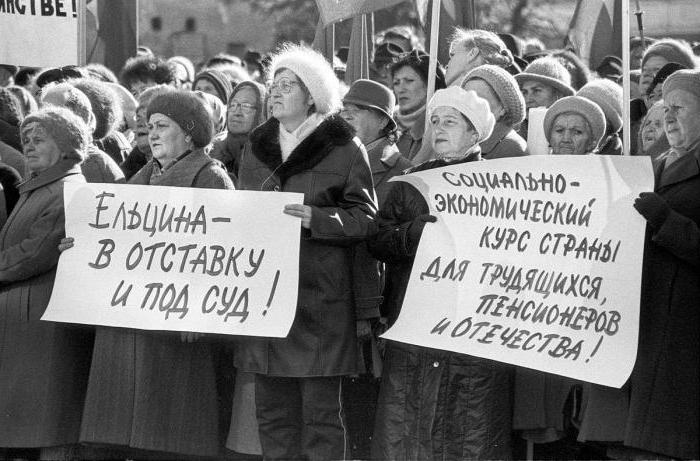
After the collapse of the Soviet Union, an influx of foreign investors was expected, but this did not happen. Foreign businessmen, analyzing the unfavorable situation in the country, refused to invest significant financial resources in a deliberately unprofitable business. Domestic enterprises were frozen. The projects, which were still supposed to be implemented jointly, had black bookkeeping and did not play any role in stabilizing the economy.
Aggravating factors
The causes of the 1998 crisis are quite extensive. But there are a number of special factors that distinguish the development of precisely this economic imbalance from other crises. First of all, financial instability was explained by the overflow of money circulation channels with excess money supply. The government had no choice but to take such measures that reduced the quality of life of the population.
The state tried to pay off current debts. As a result, nothing could be accumulated. Huge amounts of money went into the implementation of projects that were supposed to somehow help the country out of a difficult financial situation. But most of the funds were wasted.
The Russian economy in the nineties was speculative. People had no choice but to survive dishonestly. Many pursued high incomes and did not neglect illegal methods. It also happened that industrial giants were sold for a penny.
Domestic industry was on the brink of disaster. There were simply no real plans to save or launch enterprises. The owners were left face to face with the solution of their problems. Moreover, fiscal policy was aimed at collecting the last profit from enterprises.
Also, the 1998 crisis was largely due to financial instability in the world. The fall in energy prices played a role.

All these factors greatly strengthened the already unfavorable situation, which was provoked by the erroneous actions of the government. The authorities could not form the current legislative base and economic program of the state weakened by political events.
Interested people
The economic crisis in Russia 1998 arose thanks to the inept leadership of the government. But it cannot be said that the reason was only a poorly chosen strategy. The authorities were clearly aware of the consequences that would arise after a series of decisions were taken.
In an attempt to default, economists tried to achieve some shifts. Firstly, it was planned that due to the devaluation of the ruble, the volume of tax fees received would increase. Secondly, by the decision to freeze the accounts of foreign borrowers, the authorities tried to improve the situation in the banking industry.
The situation was aggravated by strife in the government. The communists, then the liberal parties, constantly pulled the blanket over themselves. The struggle for principles and power led to the fact that the people suffered.
Timeline
The consequences of the 1998 crisis would not be so deplorable if it were not for the individual events that occurred, one of which was the so-called “Black Tuesday”. In the ninety-fourth year, there was simply a collapse of the ruble against the dollar. At the same time, a proposal was put forward to stop lending to the budget deficit. Such a necessary measure was supposed to improve the financial situation. But this would happen under certain conditions:
- establishing a system of taxes and fees;
- refusal to receive investments.
But due to the fact that the destructive processes of the economy were reflected primarily in the common people, there was simply no one to pay the entire amount of tax fees. Nobody wanted to finance projects and engage in attracting investments.
The 1998 crisis took such a turn thanks to the years preceding it. During this period, an incredible level of use of treasury bonds was observed, which should have been real money. In fact, treasury bills were only substitutes that were introduced by business entities for arbitrary payments. Such a situation did not satisfy the interests of either private or state-owned entrepreneurs. At the same time, the state created an additional barrier in the business sphere by raising taxes.
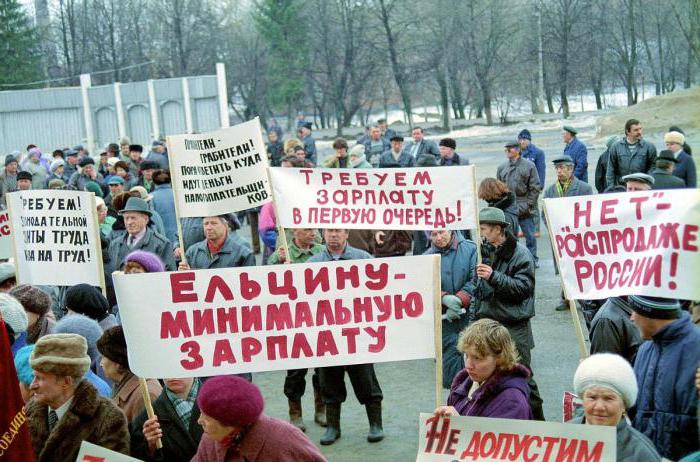
It can be concluded that the crisis of 1998 has been taking shape for a long time. Its consequences are visible to this day, they have an impact on the modern economy of Russia. Then, when the reformers Nemtsov and Chubais were at the helm, the country was not able to fulfill debt obligations. They proposed to reduce the state budget by thirty percent, which made it possible to pay part of wage arrears, but the total financial loan only increased. The country was on the verge of a riot.
Crisis peak
What else can be said about the causes and consequences of the 1998 crisis? All this was reflected in the attitude from the outside: the Duma does not agree with such risky reforms, the International Monetary Fund, which, in turn, refuses to provide loans, does not agree with this policy. Without financial tranches from this organization, it is impossible to imagine the repayment of debts that have arisen from non-payment of utilities and tax fees. Every day the situation of the state was getting worse, indicators of quality of life steadily fell.
All this was clearly expressed in inflationary processes, the depreciation of the local currency and the collapse of stock markets. The loss of credibility among foreign investors was caused by the liquidation of Tokobank. This touched foreign partners, because most of the capital belonged to them. The event provoked a sharp outflow of currency.
Unstable political relations with various states have led to the fact that the credit rating of the Russian Federation has fallen. Particularly heated debates erupted over the issue of Chechnya. The International Monetary Fund flatly refused to provide a loan, and the government found another way. The solution was debt obligations to the Europeans, who provided the necessary amounts only at huge interest. The conditions Russia agreed to were many times worse than the already stringent IMF framework.
The 1998 crisis was gaining momentum as the country's debt doubled. And this does not even take into account credit obligations of the former Soviet Union.
The ratio of the ruble to the dollar was seven to one, but that was not the limit. Due to the fact that the authorities did not pay foreign loans, the ratio of currencies grew to one dollar to seventeen rubles. Many entrepreneurs suffered losses, and prices were simply uncontrollable. By mid-September of the ninety-eighth year, the dollar was equal to twenty Russian rubles.
Personnel shifts
In the same year, the government attempted to resolve the situation. The first step was a change in the governing apparatus. Many heads of ministries have changed. Personnel shifts contributed to the revitalization of the work in the direction of overcoming the crisis. A special commission was created that was directly involved in resolving this issue. As a result, changes in power ended with the resignation of Yeltsin. The new government began to establish relations with foreign partners, which led to an increase in Russia's authority in the world community.
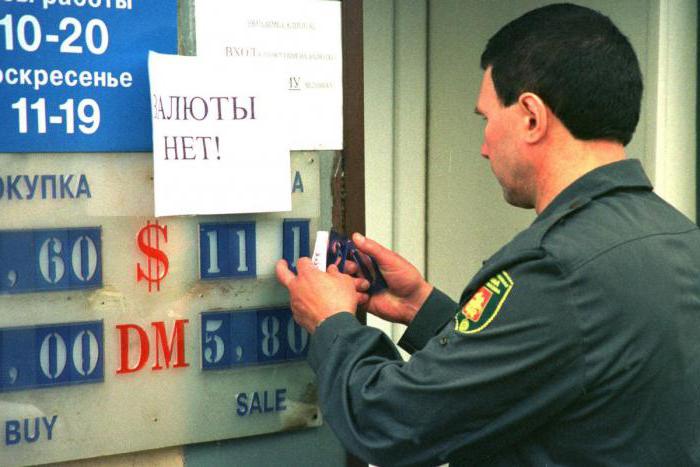
Consequences for the people
The economic crisis of 1998 was most affected by ordinary residents of the state. They no longer trusted either the local currency or the banking system. The authority of this sphere was greatly undermined. Many financial institutions were forced to stop their work, which led to the liquidation of enterprises. Small and medium-sized businessmen simply could not conduct normal activities, because the work of the banking system was frozen for six months.
Most of the citizens lost all their savings. In early 1999, a survey was conducted among the population. Citizens were asked only one question: “Are you afraid of losing all your savings?” The majority of respondents answered “no,” people had nothing to lose. The crisis forced many to stand on a slippery slope; a large number of citizens were accused of financial fraud and speculation.
Positive points
But even such an adverse event as a crisis has some positive aspects. These include:
- concern for national security, because at that time a wave of liquidation of enterprises led to the leakage of personnel abroad;
- raising the priority of economic growth;
- abandonment of a policy of large-scale loans;
- payment of social debts;
- credit rating increase;
- limiting the growth of natural monopolies;
- increasing the confidence of citizens.
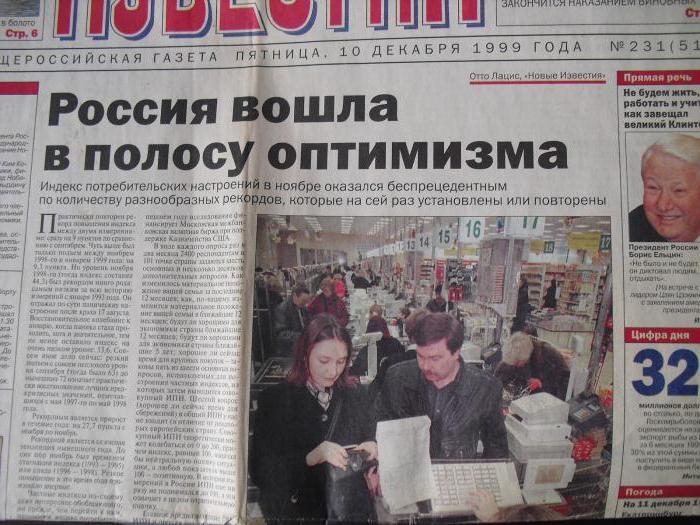
The financial crisis in Russia was disadvantageous to other countries. Other states feared an uncontrolled situation, but a positive result from their help was not observed. This imbalance helped to identify problems in the economy of the Russian Federation, as well as measures to solve them.